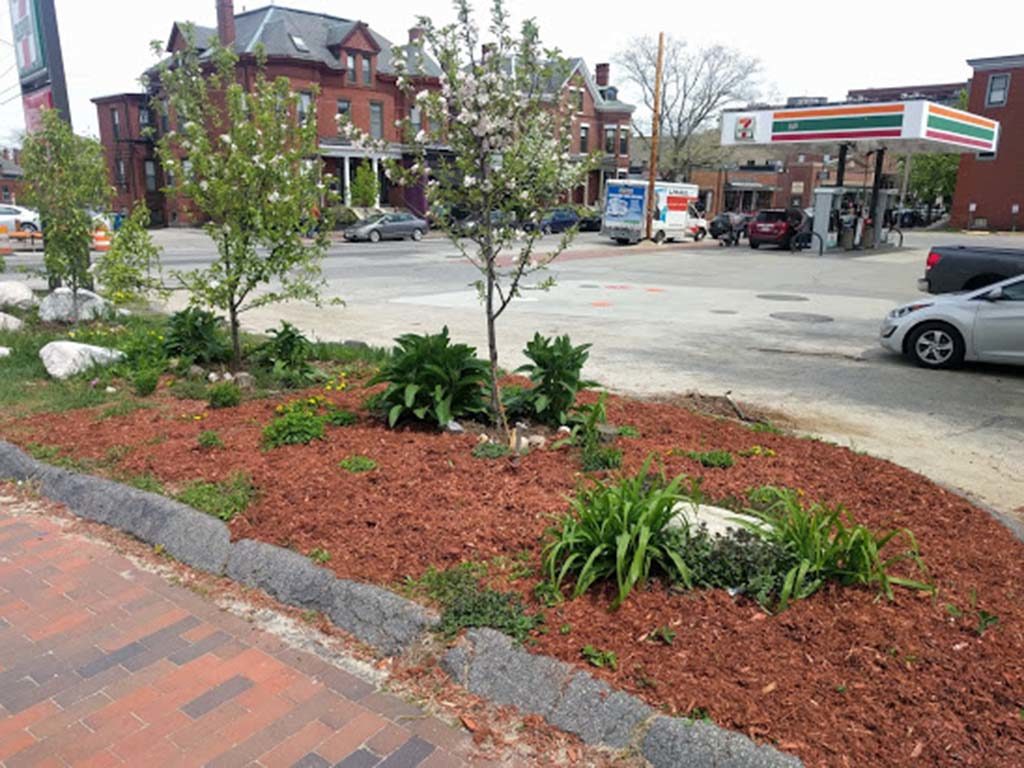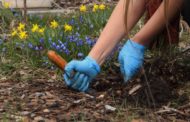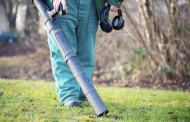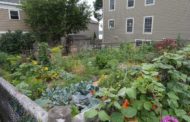Three years of strategic planting and coaxing demonstrate that urban food gardens can grow almost anywhere.
By Matt Power

If you happened to walk by the 7-11 parking lot at the corner of Dow Street and Congress Street in Portland this fall, you may have seen the evolution of an eye-catching urban garden.
About three years ago, my partner Melissa and I decided to tackle the only open piece of ground near our house on Dow Street. With permission from the 7-11 owners, we began to systematically apply permaculture strategies to bring life back into soil that looked more like fireplace ashes than dirt. Three previous trees on the spot died long ago, leaving only stumps, and scrub grass and weeds struggling to survive.
Power of ‘Permaculture’
This narrow strip of land (mostly hidden by snow at this writing) now includes two healthy apple trees, a pear tree, a blueberry plant, strawberries, along with ample comfrey, and several herbs and medicinal plants including yarrow, oregano, thyme, sage, and chives. You’ll also find speedwell, daylilies, clover, salvia, and Creeping Charlie as a groundcover.
This garden showcases the power of “permaculture.” We’ve noticed many small pieces of land in the City where harsh chemicals, dog droppings, trash, and neglect have damaged soils. We wanted to show that even the worst land may be rejuvenated, if you apply the right techniques and patience.
How It’s Done
The process requires a lot of heavy mulching, along with careful planting of different species of plants that assist the trees as they take root. For example, the leafy comfrey plants around the trees are called nitrogen fixers (forgive me if you know all this stuff already). They extract nitrogen from the air and deposit it into the soil, especially if you trim them and let the leaves rot around the trees.
Other plants, such as the clover and Creeping Charlie groundcover, keep the soil cooler and allow plants to better respond to drought.
Each year, the amount of work we volunteer in the garden has decreased. We water only about one third as much as we did the first year, and the groundcover is gradually replacing the old scrub grass that was there.
We’ve planted sunflowers in the areas that still need work, because they extract heavy metals from the soils and provide food for birds and squirrels. Later, we’ll replace them with perennial plants like the upper half of the garden.
The 7-11 parking lot is now alive with bees and sparrows, or at least will be again by mid-summer.
We believe a place of peace, beauty, and food brings many intangibles to the city. So many cool things have happened since we started the project. Less trash is thrown into the area. People with mental illness sometimes sit among the birds and bees and find a moment’s solace. Older neighbors stop by and ask about the plants and thank us for creating a place they enjoy as they walk home. Someone has put many beautiful painted stones around the trees.
We have even had some of the regular alcoholics in the area offer to “guard” the garden and “kill anyone who goes near those trees!” We thanked them for their kind offer and told them that was probably a bit excessive…
This year, our hard work really produced, in a tangible way, when the two apple trees sprang forth with a couple of hundred delicious apples.
Next on the agenda, to identify other properties in the area where magical food forest gardens could appear in coming years, and interest other neighbors in “adopting” a patch of neglected ground.
Matt Power
Matt Power is a West End resident and board member of The Resilience Hub (resiliencehub.org), a Portland-based organization that brings permaculture and community together. He is also the author of “The Tiny House Tactical Guide,” and Editor-In-Chief of Green Builder Magazine.
Originally published at www.resiliencehub.org/2018/12/07/edible-abundance-next-to-the-7-11-parking-lot.





